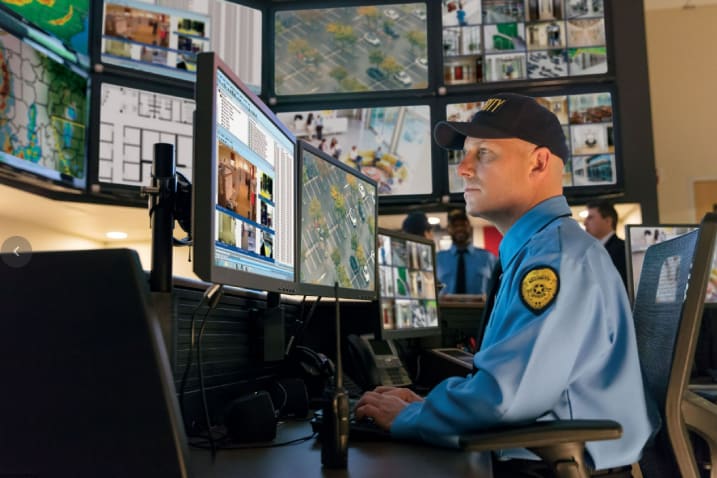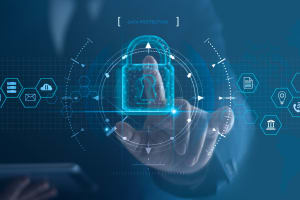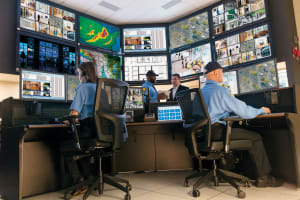What is Access Control? A Comprehensive Guide.

Access control is a security measure that protects resources, areas and assets ensuring only those authorized can gain access. In today’s environment, it’s important for organizations to have strong security protocols in place to prevent threats such as vandalism and theft and to keep their employees safe.
This blog post will explore access control in depth. First, it is important to discuss what it is, how it works, the different types of access control, why access control is crucial, and some of the challenges associated with it. Then, we will discuss how to implement access control and LenelS2's access control solutions.
How Does Access Control Work?
There are several components involved in access control, but some of the basics include:
Authentication
Access control systems typically work by registering people and granting them access authority to what they need to get their jobs done. When a user presents their credentials in the form of a badge or mobile credential, the system authenticates the user and then determines what they are authorized to do. This will determine if they have access to specific assets or areas. Authentication is the process of verifying a user prior to giving them access. This can be done through credentialing, biometrics, or security tokens.
Authorization
Once a user has been authenticated, the access control system will check to see if they have the proper authorization to access the resource they are trying to access. If they do not have the proper authorization, they will be denied access.
Access
Once the identity of the authenticated and authorized user is verified, the user will gain access.
What is the Difference Between Authorization and Authentication?
Authentication is the process of verifying that a user is who they claim to be. This is commonly done through the use of mobile credentials, which uniquely identifies a person. Authorization is the process of determining whether a user has access to a particular area. This is typically done by checking to see if the user's credentials are within the list of approved individuals for that specific area.
Different Forms of Access Control
Access control comes in many different forms. Listed below are a few examples:
Physical Badges
A physical access control system typically uses physical badges to authenticate users. Badges can be in the form of keycards, fobs, or even smartphones. As physical security continues to evolve, mobile credentials have become a more secure and convenient alternative to standard physical keycards. Since smartphones typically need pin codes, fingerprints, or face IDs to unlock them, mobile credentialing poses less of a security risk if lost or misplaced.
Biometrics
Biometrics is a type of authentication that uses physical or behavioral characteristics to verify a user's identity. Common examples of biometrics include fingerprint scanners, iris scanners, facial recognition, and voice recognition systems.
Bluetooth
Bluetooth access control systems use Bluetooth low energy (BLE) technology to authenticate users. BLE access control systems typically use smartphone apps as the means of authentication.
Electronic Wallets
Electronic wallets can be used to authenticate users. To use an electronic wallet for access control, the user would simply need to hold their smartphone up to an access control reader. One they have had their credentials loaded into their Electronic wallet.
Components of Access Control Systems
Access control systems consist of several components that work together to regulate access points. Here are the key elements of an office access control system:
Access Management Software
Central Control Unit
The central control unit is the core of a commercial access control system which manages and initiates all system functions. It contains software that processes input from door readers and credentials, and once a person is verified, commands are sent out to unlock the access point.
Electromechanical Locks
These locks work with the control unit and readers to secure or unlock doors. Options range from traditional electric strikes to advanced smart locks with features like remote and real-time unlocking capabilities.
Entry Readers
These devices are placed at access points to verify user credentials. Entry readers can include card readers, biometric scanners, or keypads. The type of reader depends on the desired security level and the method of authentication.
Benefits of Access Control
Implementing an access control system can lead to a large range of benefits, including:
Protection Against Unauthorized Physical Access
Access control helps safeguard against unauthorized entry to buildings and individual assets.
Ensures Authorized User Access
It ensures that only individuals with proper authorization can access sensitive information and secured spaces.
Enhances Physical Security
By restricting access to certain areas, access control strengthens overall physical security.
Improves Operational Efficiency
Efficient access management can streamline operations and reduce unnecessary interruptions.
Secures Important Facilities
Access control ensures critical facilities are locked and protected as needed.
Limits Access to Specific Assets and Locations
Access control provides precise control over who can access specific resources or equipment.
Mitigates Risks from Malicious Actors
Access control helps prevent and manage potential threats from individuals with harmful intentions.
Challenges of Access Control
There are several challenges for companies looking to implement or improve their access control solutions.
Emergence of Threats
Every single day, malicious actors are looking to get through controls to cause harm or gain access to the Intellectual Property and trade secrets that make a company viable in the market. There are constant threats that your organizations will have to stay ahead of in order to keep your assets secure and your people safe. As technology becomes more sophisticated, these threats become more complex and difficult to address.
Even for buildings just trying to secure their facilities with locks, cybersecurity is a major concern. Many access control points are protected via digital systems, making it difficult to protect assets and areas of the building if there is a breach. Security staff may not have the technical knowledge or IT resources to manage complex access control systems. Additionally, regular updates are important components in keeping these systems running smoothly. The right security solution will make it easy to deploy these updates while managing the ever-evolving cybersecurity threats.
Doing More with Less
At the same time, many organizations are stressed by the need to do more with less. Teams need to become more efficient and look for ways to save costs. However, as the business scales, individuals may still be sifting through alarms and events to determine what is critically important and what is a nuisance alarm.
Fortunately, advanced access control systems can leverage artificial intelligence and machine learning to automate responses to events and alarms, even detect the potential of system failures before they happen allow for optimal use of personnel and reducing unplanned system outages
Handle a Geographically Dispersed Set of Assets
As global business operations continue to accelerate, security teams may be managing access control for various cities and countries from one central location. However, a centralized system can pose problems if not managed correctly, since communication becomes increasingly important. In the case of an event or emergency, security will need protocols in place to quickly get a hold of local teams and address these situations.
The Return to Work
After COVID, many companies embraced a hybrid or fully-remote workforce. In doing so, security teams needed to adapt quickly to change or update credentials based on ever-changing access needs. Additionally, if remote employees are traveling and they need access to new building or assets for an in-person meeting, security teams must be able to grant access rights easily and quickly.
How to Implement Access Control
When implementing access control, it is important to consider the needs of your organization. This includes factors such as the size of your organization, the type of entry points you need to protect, and the level of security you require. In addition, you will need to decide which access control solution is right for you. There are many different access control solutions on the market, so it is important to do your research and choose a solution that meets your specific needs.
Access Control for Specific Industries
Access control needs vary by industry, making it important that companies looking to improve their security, invest in a tool that can cater to and adapt to current and changing needs. Below are specific needs for different kinds of industries.
Government
The federal government and its respective agencies need to protect information from an intelligence standpoint while managing various levels of access based on clearance. Government agencies may also have specific compliance needs when implementing an access control system. They need to do this for areas and assets that are critical for national security and where malicious actors are constantly trying to infiltrate.
K-12 Schools
K-12 school systems need access control solutions that will keep doors locked and children and faculty safe. Since these facilities are also often used for other community events, there may be different profiles of what's available to the general public at different times of the day. In schools there needs to be a delicate balance between having the facilities accessible to the public yet controlled to protect our most important assets, our children.
Higher Education
Higher education poses different challenges to college campus security professionals since students will often require access to more buildings, due to their major, dorm room, or side jobs. Campuses may also be closed or open, making credentialing capabilities particularly important. Also, universities have many events that occur on a regular basis that have a constant need for changes to enable access and remove access.
Pharmaceutical & Healthcare
Pharmaceutical companies’ profits are based on their intellectual property and investment into R&D. Access control focuses on protecting this intellectual property by restricting access to specific buildings, labs and rooms while having systems in place to address unauthorized access and the ability to change access rights quickly. This is also an industry anomalous behavior can provide indicators of threats from the inside such as an employee who maybe gathering data for a move to a competitor.
For hospitals, visitor management and video surveillance are important tools to protect patients, sensitive information and staff. With the right solution, healthcare companies can comply with HIPAA requirements or meet JACHO standards while providing the best care for patients and keeping the staff safe
Manufacturing
Manufacturing access control needs not only focus on providing access to facilities, but also on access to various types of assets. With the right solution, companies can only authorize individuals to use equipment if they meet the certification criteria. The right solution will also help companies ensure compliance related to OSHA keeping employees and authorized visitors safe.
Access Control Case Studies & Examples
The following are just a few examples of how businesses achieved access control success with LenelS2.
Case Study#1: Brooklyn Navy Yard Uses Access Control for Their Shuttle Bus Program
One of the United States’ most storied naval shipbuilding facilities for over 150 years, the Brooklyn Navy Yard needed a way to ensure that only authorized people boarded the free shuttle buses that made the property accessible to employees, contractors, visitors, and tenants. With LenelS2’s NetBox access control system already in place at the Yard entrances, they reached out to LenelS2 and systems integrator, Advanced Electronic Solutions, Inc. (AES), to craft an access control solution for the shuttle bus program. The new system ensures only tenants and visitors are using the shuttle bus system to arrive at the facility.
Case Study #2: Granite Falls School District Uses Video Surveillance to Secure Schools
Located in Washington State, Granite Falls School District is responsible for educating 2,000 students across five different schools. Its previous security infrastructure was expensive, challenging to maintain, and disparate, so it turned to LenelS2 for a solution. The NetBox™ access control system provided accessibility from anywhere, giving the District more flexibility and control. Anyone with privileges can view events and video from a desktop or a mobile device. All while maintaining Granite Falls’ standards at each school. The budget surplus from the initial project made it possible to add capabilities such as custom-configured, discrete panic alarms (assistance, medical emergency, lockdown). Thus, the district was able to implement a unified security approach complemented by advanced integration, all while staying under budget.
Case Study #3: Edison Properties Uses Custom Integrations for Access Control
The Newark-based real estate holding and development firm’s legacy security system was expensive to maintain and challenging to integrate with third-party systems. Seeking a flexible security system, Edison Properties concluded that LenelS2 would best meet its diverse needs. The final solution made use of NetBox and NetVR systems to provide unified access control and video management. The flexible, open NetBox system API allowed Edison Properties to write its own integrations and tailor the system to each of its individual brand’s needs. The company is also running the system on centralized virtual servers at an off-site data center. Without the demands of a physical installation, Edison Properties saves additional time and money.
LenelS2 Access Control Solutions
LenelS2 provides a variety of access control solutions that can be tailored to meet the specific needs of any organization. We have helped businesses of all sizes unify and modernize their systems. Our traditional access control solutions include the OnGuard access control system, a feature-rich system designed to integrate with a range of other security, business, and building systems, the NetBox browser-based access control and event monitoring system that is intuitive and easy to scale. We also offer cloud-based access control solutions, such as the Elements solution and the OnGuard Cloud solution.
With over 200 certified product interfaces and an open API, you can truly optimize your LenelS2 access control system to meet your needs for a variety of third-party integrations, from human resource databases to elevator control.
At LenelS2, our institutional experience and knowledge are unmatched in the industry. Moreover, our global reach means we can help you understand threats, authorization, rules, regulations, and privacy requirements in different parts of the world. If your organization needs dedicated security system support, our expert team is ready to offer comprehensive assistance, ensuring your security infrastructure meets global standards.




